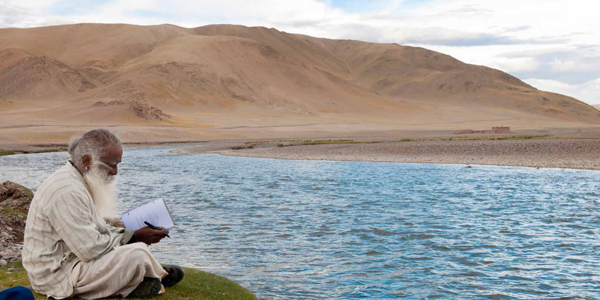Rivers in India: Problems and Solutions

“In our economic lust, let us not forget that it is our land and rivers that sustain us.” —Sadhguru
India’s rivers, the nation’s lifeblood, are facing an alarming crisis. Sadhguru outlines what we can do to breathe life back into the rivers before they leave us high and dry.
Sadhguru: We are who we are because of our rivers. India has essentially grown along the banks of major rivers. Our ancient civilizations like Mohenjo-Daro and Harappa were born along the waters, and they died when the rivers shifted course.
Today, our rivers are depleting at such a rate that they will become seasonal in 20 years’ time. In the last 10 to 12 years, I have seen a dozen rivers going dry in Tamil Nadu alone. Today, the waters of the Kaveri, the Krishna and the Godavari, the most significant rivers of southern India, flow to the oceans only for a few months in a year.
The Flipside – Excess Rain
As global warming causes temperature rise, the southern peninsula – with oceans on both sides – will naturally receive excess rainfall. We already see the coastal regions of Andhra Pradesh going mostly underwater during the monsoon. And after the December floods happened in Chennai, people have become afraid of rain. Two days of rain in Chennai is enough to put all the rescue boats on the alert!
Excess rains will turn the southern peninsula into desert much faster than if there was no rain. It will leach the land and make it totally improper for cultivation over a period of time – which is already happening very rapidly in Tamil Nadu. Bore wells that used to hit water at two hundred feet are being dug to 1000 feet, and still there is no water!
How long are we going to run the country with water trains and trucks? It is not possible to feed the thirst of this country with trains or pipelines. I do not want to be alarmist, but everyone should think about the real problems we are creating with our treatment of the rivers. With more than a billion people, if rivers dry up, what will people do? Can they kill each other and drink blood?
We cannot immediately restore our ice-fed rivers because the volume of ice and snowfall are global phenomena, but we can certainly breathe life into those of our rivers that are forest-fed. People want emergency solutions and are trying to move the policy-makers to try to connect the rivers and deliver water to more areas of land. That is going to be even more disastrous. We will only spend enormous amounts of money and create an even bigger ecological disaster.
Trees for Life!
What is needed is a broader solution which starts by creating an awareness about what we are doing to the rivers and what we should do instead. Simply inspiring people to take action is not sufficient. Only if we offer profitable solutions can we convince people to save our rivers. We can employ 100,000 people to plant trees and nurture them for the next ten years and bring an enormous amount of land under green cover. In this way, we will invite the monsoons to be more regular, and can stop the erosion of our soil. This is a comprehensive solution and it will not cost more than 10% of what linking the rivers will cost.
A Plant Buffer
And for one kilometer along either side of the river banks, let us not do agriculture because when farmers plough up the banks, fertilizers and pesticides seep into water, affecting life. We need to create a plant buffer for our rivers. For land belonging to the government, plan for afforestation, and for private land, horticulture. The governments can provide education, and subsidize these efforts for three to five years, and help develop a whole new system of high-quality organic horticulture. Farmers will not mind giving up their regular crops, nor will they be coerced to migrate to cities for other work because their land will still continue to yield a living – even better than what they had before.
Governments have to create river-friendly policies. The governments of Andhra Pradesh and Madhya Pradesh are taking initiatives in this direction. Right now we are making a project proposal to present to the government of India, as to how this method of farming is more profitable than agriculture.
Today, too many people have become a totally defeated population because they believe nothing will change, irrespective of what they do. But now is the time to make a change. Ten years later will be too late. In our economic lust, let us not forget that it is our land and rivers that sustain us. Our rivers have been on for millions of years. Let our generation not kill them. If each one of us can plant one tree this year, nourish it for two years, and after two years plant one more tree, we have a phenomenal movement going. It is not a question of whether we can do it or not. Do we want to do it or not? – is the only question. Let us make it happen.
Editor's Note: “A Tree Can Save the World” is more than just a book! It is a call to action from Sadhguru. Making it clear that “when it comes to ecological work, it is not somebody’s work, it is everybody’s work,” Sadhguru links the responsibilities of people, business and governance to address the problem with both short-term action as well as long-term vision. Name your own price and download.


